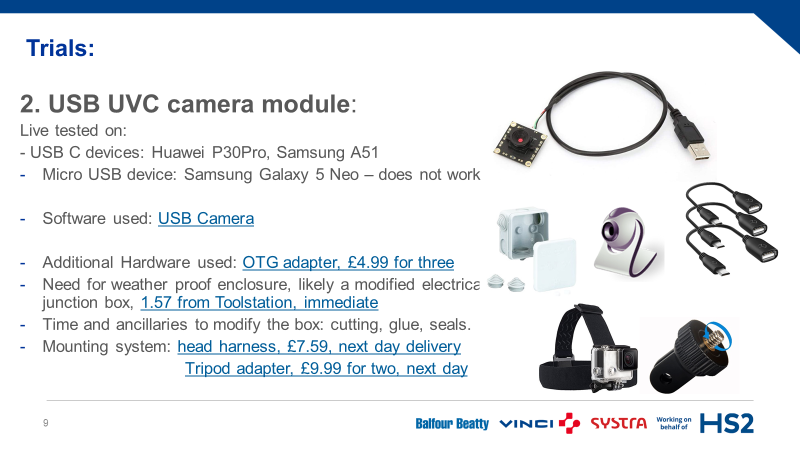Real-time virtual site tour system
The pandemic led to the need for significant advancement in virtual working. As a result, Team Old Oak introduced a virtual hands-free streaming solution that allows members of the Integrated Project Team to view and interact with the site area ‘virtually’ in real time, from the safety of their computers.
This reduced the need to attend site in person, alleviating the proximity threat posed by COVID-19, as well as the threat associated with the interface between people and plant, machinery or live construction works.
The USB camera app has been successfully trialed at Old Oak Common and will contribute to the overall advancement in safe working, whilst also improving efficiency for design and engineering teams on the project
Background and industry content
Old Oak Common Station construction project is part of the High Speed Two (HS2) phase one works, being delivered by the OOC Integrated Project Team (IPT) including Balfour Beatty Vinci Systra joint venture (BBVS JV) and WSP.
As a result of the threat caused by COVID-19, many of the BBVS workforce who would usually be on-site, were required to work from home. While this was essential to keep team members safe, this way of working has a number of limitations, including reducing the ability for employees to interact with the live construction site, in real time.
As a result, BBVS developed an external camera for videoconferencing through Android mobile. This is an effective way for operatives to engage with construction works and communicate regarding these works in real time.
The basis of the idea was to have visuals of the site live streamed to a person working remotely. Capturing this footage needed to be done safely and therefore a mobile phone or handheld device that forces operatives to view site through a screen, would not suffice.
As a result, a weatherproof hard-hat camera was developed. The camera is connected to the operator’s mobile phone via a USB cable and transmits visuals via an Android app. The app then connects the stream to a live video conference being held on Microsoft Teams or Zoom.
Components
During development, a number of different solutions were considered. However, a system utilising the following components was settled on as the best solution due to both affordability, availability, and flexibility.
- Android mobile phone
- OTG (On The Go) adaptor
- Web camera – sealed joints
- Head mount harness on hard hat


Using the live streaming system
The system was developed to be easy to set-up and video content is available to anyone with Microsoft Teams or Zoom.
Set-up steps:
- Pair the Bluetooth headset to the phone
- Connect the camera to OTG adapter. This must be a micro USB or USB C adapter.
- Plug OTG adapter into the mobile phone.
- Open the “USB CAMERA” app.
- Provide the permission to use the USB camera device.
- Open Teams call, ensure you are using the Bluetooth headset.
- Click ‘share screen’.
- Provide permission to draw over other apps
- Share ‘USB camera’ app screen by pressing the square button at bottom of screen and choosing the application.
- Check you are connected, and people can see the stream.
Successes
In January 2021 the Health, Safety, Security, Quality and Environment (HSSQE) team successfully held the first virtual tour of the Old Oak Common site via Microsoft Teams. The virtual safety tour was attended by ten people, including the Health and Safety (H&S) leads from the project’s four parent companies: Balfour Beatty, Vinci, Taylor Woodrow and Systra. Great feedback was received from all of the attendees.
While the system has a definite benefit in terms of allowing for virtual site tours for H&S reasons, it also has utility for a number of other functions. The live stream allows engineering teams to deliver immediate instructions and advise engineers and workers on site when they aren’t able to be physically present. It allows for virtual progress updates, site tours, issue investigations and design clarifications.
Possibly the most useful function of the innovation is that it allows individuals to take a ‘self-guided’ tour of the site. By interacting with the operator, viewers can provide instructions such as asking to see a specific location or zooming in on a specific area of concern.
Recommendations and lessons learnt
The hands-free streaming solution would not work well in areas of poor or no mobile network on site. It has also been reported that there has been difficulty syncing the USB camera app to MS Teams during the initial trial.
While the innovation provides particular benefits relating to minimizing the need for contact between team members, it also has wider reaching long term benefits. By minimising the requirement for operatives to be physically present on construction sites, it reduces the opportunity for accidents caused as a result of proximity to plant, live construction works, or other site hazards.
Acknowledgements
Phillippe Galley – HSSQE Manager, BBVSJV
Kiril Tasev – Digital Field Manager, BBSVJV
